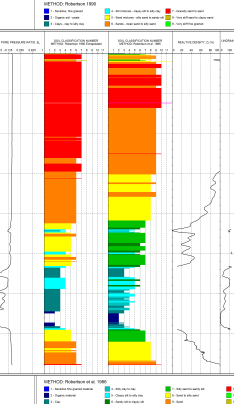CPT Tool - Soil Behaviour Type

CPT Tool
The most user-definable Cone Penetration Testing software available.
Work without limits as you define which types of soil data to present in log, fence, cross-section and graph reports.
- Define correlation formulas and reports
- 200+ Preconfigured correlations and derivations
- 600+ customisable log, fence/cross-section and graph reports
CPT Tool places advanced reporting directly in the hands of geotechnical engineers with code-free report definition and an array of formula configurations, analysis and report options unmatched in cone penetration testing.
Speed up soil data interpretation with rich-data visualisation in any situation, adapting reporting output to changing requirements and conditions across projects.
CPT Tool - Soil Behaviour Type
The CPT Tool is supplied with seven Soil Behaviour Type (SBT) interpretation methods:
- Begemann (1965)
- Eslami and Fellenius (1997)
- Ramsey (2002)
- Robertson (1990)
- Robertson, Campanella, Gillespie and Greig (1986)
- Schmertmann (1978)
- Schneider, Randolph, Mayne and Ramsey (2008)
The following Soil Behaviour Type Index (Ic) correlations are defined in the Formula Tool:
- Been and Jefferies (1992)
- Jefferies and Davies (1993)
- Robertson and Wride (1998)
- Robertson (2010) - Non-normalized Soil Behaviour Type Index, ISBT
Additional polygon based methods and formula based methods may be defined by users, and stored in both the library and project.
The SBT can be summarised on to your existing borehole description lithology/stratigraphy table. Your existing material graphic code can be associated with each SBT number, geotechnically insignificant layers may be excluded, and thin layers of the same type (fine/coarse) can be appended together.
 Two SBT columns on a Log |  Example SBT graph |
